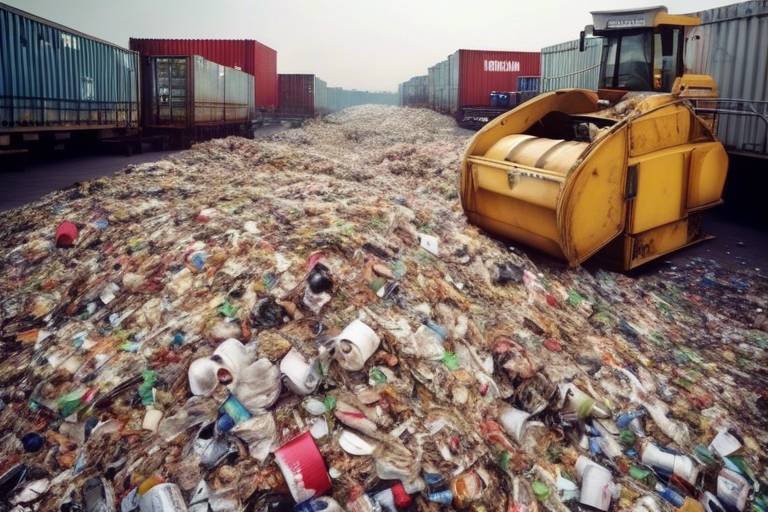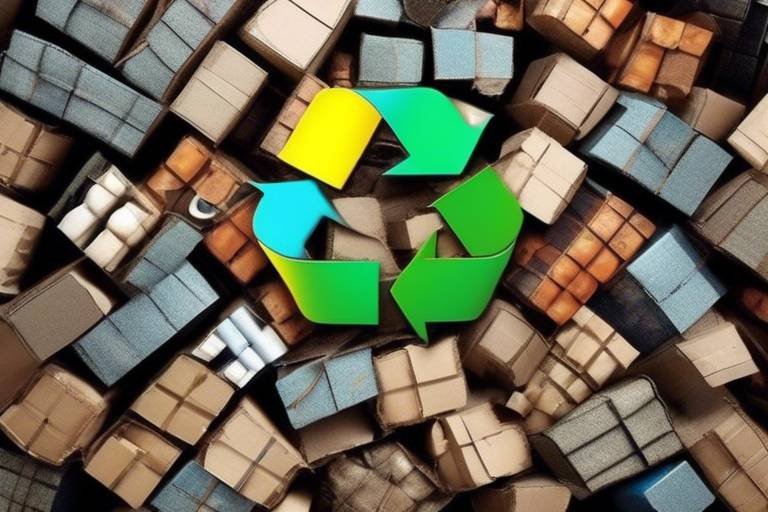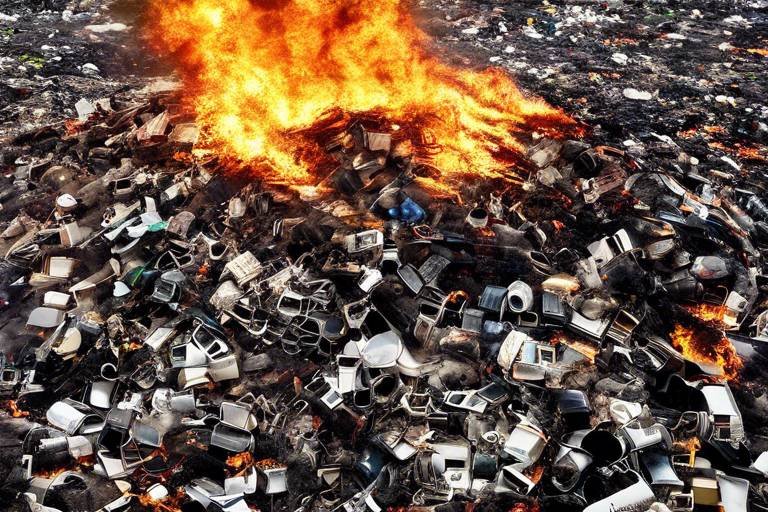How Can Digital Technology Help Reduce Paper Waste
In our fast-paced, digital-driven world, the need for sustainability is more pressing than ever. With the increasing awareness of environmental issues, many individuals and businesses are looking for effective ways to minimize their ecological footprint. One significant area where we can make a difference is in the reduction of paper waste. It's astonishing to think that billions of trees are cut down every year to meet the demands of paper production. However, the good news is that digital technology offers a plethora of solutions to help combat this issue. From digital document management systems to cloud storage and innovative collaboration tools, the transition to a paperless environment is not just a dream; it’s becoming a reality. Let's dive into how these technologies are reshaping our approach to paper usage and promoting sustainability.
Implementing digital document management systems can significantly reduce paper usage. These systems allow for organized storage, easy retrieval, and secure sharing of documents, minimizing the need for physical copies and enhancing efficiency. Imagine a world where you no longer have to sift through piles of paper to find an important document. With digital document management, everything is just a few clicks away. You can categorize your files, set access permissions, and even track changes made to documents. This not only saves time but also reduces the clutter that physical documents create, leading to a more organized and productive workspace.
Cloud storage services provide a sustainable alternative to traditional paper filing systems. By storing documents online, users can access their files from anywhere, reducing the reliance on physical storage and minimizing paper waste. Think about it: no more bulky filing cabinets or endless stacks of paper. With platforms like Google Drive or Dropbox, you can store thousands of documents securely in the cloud. This not only helps in reducing paper consumption but also offers the flexibility of accessing your files on-the-go. Plus, cloud storage often comes with backup features, ensuring that your important documents are safe and sound.
Digital collaboration tools facilitate teamwork without the need for printed materials. Platforms like Google Workspace and Microsoft Teams allow users to share and edit documents in real-time, promoting a paperless workflow. Picture a scenario where your entire team can brainstorm, edit, and finalize a project without ever printing a single page. These tools not only enhance productivity but also foster a culture of collaboration and innovation. By reducing the reliance on paper, teams can focus more on their work and less on the logistics of printing and distributing physical documents.
The rise of remote work has led to decreased paper consumption. Employees can work from home using digital tools, reducing the need for printed documents typically required in an office setting. In this new era of work, the traditional office setup has been replaced with virtual meetings and online communication. This shift not only promotes flexibility but also encourages a more sustainable approach to work. By embracing remote work, companies can significantly cut down on their paper usage, leading to a greener future.
Digital signatures eliminate the need for printing, signing, and scanning documents. This technology allows for secure and legally binding agreements without the use of paper, streamlining the signing process. Imagine being able to sign a contract from your smartphone while sipping coffee at your favorite café. Digital signatures not only save time but also contribute to reducing paper waste significantly. With the ability to sign documents electronically, businesses can operate more efficiently while being environmentally conscious.
Automation tools can help organizations streamline their processes, reducing the need for printed forms and reports. By digitizing workflows, businesses can minimize paper consumption and improve operational efficiency. Think of automation as your new best friend in the workplace. It takes over repetitive tasks, allowing you to focus on what truly matters. Whether it's generating reports or processing invoices, automation reduces the reliance on paper, making your operations smoother and more sustainable.
Raising awareness about the environmental impact of paper waste is crucial. Educational initiatives can encourage individuals and organizations to adopt digital solutions and practices that contribute to reducing paper usage. It's essential to understand that every small step counts. By educating ourselves and those around us, we can foster a culture that values sustainability. Workshops, webinars, and community events can play a significant role in spreading this awareness.
Conducting workshops and training sessions can equip employees with the skills to utilize digital tools effectively, promoting a culture of sustainability and reducing reliance on paper in the workplace. Imagine an office where everyone is proficient in digital tools, leading to a significant reduction in paper usage. These training sessions can empower employees to embrace technology and make informed choices about their work processes.
Engaging the community in sustainability efforts can amplify the impact of reducing paper waste. Initiatives that promote digital literacy and eco-friendly practices can lead to broader adoption of digital solutions. When communities come together to support sustainability, the effects can be profound. By fostering a collective effort, we can create a ripple effect that encourages more individuals and businesses to adopt paperless practices.
Emerging technologies, such as artificial intelligence and machine learning, are transforming how we approach document management. These innovations can optimize processes, further reducing the need for paper in various industries. With AI, businesses can automate data entry, analyze trends, and even predict future needs without ever printing a single sheet of paper. The potential for these technologies to contribute to a paperless future is immense, paving the way for more efficient and sustainable practices.
- How does digital technology reduce paper waste? Digital technology minimizes the need for physical documents through digital document management, cloud storage, and electronic signatures.
- What are some effective digital tools for reducing paper usage? Tools like Google Workspace, Microsoft Teams, and cloud storage services are excellent for promoting a paperless environment.
- How can I encourage my workplace to go paperless? You can promote workshops, provide training, and demonstrate the benefits of digital tools to encourage a paperless culture.
- Are digital signatures legally binding? Yes, digital signatures are legally binding and are recognized in many jurisdictions as a valid form of agreement.

Digital Document Management
In today's fast-paced world, has emerged as a game-changer, especially when it comes to reducing paper waste. Imagine a world where all your important documents are just a click away, neatly organized and easily accessible, without the clutter of paper piling up on your desk. By implementing digital document management systems, individuals and businesses can significantly cut down on their paper usage while enhancing overall efficiency. These systems not only allow for organized storage but also enable easy retrieval and secure sharing of documents.
One of the biggest advantages of digital document management is the elimination of physical copies. Think about it: how many times have you printed out a document only to have it sit in a pile, never to be looked at again? With digital solutions, you can store everything online, ensuring that you only print when absolutely necessary. This not only saves trees but also saves you the hassle of dealing with disorganized stacks of paper. Plus, digital documents are easily searchable, meaning you can find exactly what you need in seconds rather than sifting through piles of paper.
Furthermore, these systems come equipped with robust security features. You can set permissions, track changes, and even implement backup solutions to protect your sensitive information. This is particularly crucial in a professional setting, where confidentiality is paramount. By transitioning to a digital management system, companies can minimize the risk of data breaches associated with physical documents that can be lost or stolen.
To illustrate the impact of digital document management, consider the following table that compares traditional paper-based systems with digital solutions:
| Feature | Traditional Paper-Based System | Digital Document Management |
|---|---|---|
| Storage Space | Requires physical filing cabinets | Utilizes cloud storage, saving physical space |
| Accessibility | Limited to physical location | Access from anywhere with internet |
| Search Efficiency | Time-consuming manual search | Instant search capabilities |
| Security | Vulnerable to loss or theft | Advanced security features and encryption |
| Environmental Impact | High paper consumption | Significantly reduces paper waste |
In conclusion, the shift towards digital document management is not just a trend; it’s a necessary evolution in our approach to handling information. By embracing these systems, we can make a substantial impact on our environment while also streamlining our personal and professional lives. So, why not take the plunge? The benefits are clear, and the potential for a more sustainable future is bright!

Cloud Storage Solutions
In today's fast-paced digital world, have emerged as a game changer for individuals and businesses alike. Gone are the days when we relied heavily on physical filing cabinets stuffed with paper documents. Instead, the cloud offers a sustainable and efficient alternative that not only reduces paper waste but also enhances accessibility and collaboration.
Imagine being able to access all your important documents from anywhere in the world, simply by logging into your cloud storage account. This flexibility is one of the primary reasons why more people are making the switch to digital. With services like Google Drive, Dropbox, and OneDrive, users can store their files securely online, eliminating the need for physical copies. This shift not only helps to protect our precious trees but also streamlines our workflows, making it easier to find and share documents.
Furthermore, cloud storage solutions come with a plethora of features that facilitate better organization and management of documents. For instance, many cloud platforms allow users to categorize files into folders, share documents with specific individuals, and even collaborate in real-time. This means that instead of printing out a draft for comments or revisions, team members can simply edit the document directly in the cloud. The result? A significant reduction in paper usage!
But what about security, you may ask? Well, cloud storage providers invest heavily in advanced security measures to protect your data. This includes encryption, two-factor authentication, and regular backups, ensuring that your documents are safe from unauthorized access and potential loss. In this way, cloud storage not only contributes to sustainability but also provides peace of mind.
To illustrate the impact of cloud storage on paper waste reduction, consider the following table:
| Traditional Method | Cloud Storage Method | Paper Waste Reduction |
|---|---|---|
| Physical filing cabinets | Digital folders | 100% (No physical storage needed) |
| Printed documents for collaboration | Real-time document editing | 75% (Less printing for reviews) |
| Mailing physical copies | Emailing links to documents | 100% (No mailing required) |
As we can see, the transition to cloud storage solutions not only simplifies our lives but also plays a crucial role in reducing our carbon footprint. By embracing these technologies, we can all contribute to a healthier planet while enjoying the benefits of a more organized and efficient way of working.
In conclusion, cloud storage solutions are not just about storing files; they represent a paradigm shift in how we manage information. By moving away from traditional paper-based methods, we are not only streamlining our processes but also paving the way for a more sustainable future. So, if you haven't yet made the switch, now is the perfect time to explore the world of cloud storage and experience the numerous benefits it has to offer!
- What are cloud storage solutions? Cloud storage solutions are online services that allow users to store, access, and manage files and data over the internet instead of on local physical storage devices.
- How do cloud storage solutions reduce paper waste? By digitizing documents and allowing for online collaboration, cloud storage minimizes the need for printing and physical copies.
- Are cloud storage solutions secure? Yes, reputable cloud storage providers implement robust security measures, including encryption and two-factor authentication, to protect your data.
- Can I access my files from anywhere? Absolutely! One of the key benefits of cloud storage is that you can access your files from any device with internet connectivity.

Collaboration Tools
In today's fast-paced world, have become the backbone of teamwork, especially in the context of reducing paper waste. Imagine a workplace where ideas flow freely without the clutter of printed documents. Sounds refreshing, right? These digital platforms, such as Google Workspace and Microsoft Teams, not only enhance communication but also promote a paperless environment. By allowing teams to share, edit, and collaborate on documents in real time, these tools eliminate the need for physical copies that often find their way into recycling bins.
Collaboration tools are designed to facilitate seamless interaction among team members, regardless of their location. For instance, consider a project team spread across different cities. Instead of sending printed reports back and forth, they can easily upload their work to a shared drive. This not only saves time but also significantly reduces the amount of paper consumed in the process. The ability to comment, suggest edits, and track changes in documents means that everyone stays on the same page without the hassle of printed drafts.
Moreover, many of these platforms come equipped with integrated chat and video conferencing features, allowing teams to discuss projects in real-time. This means that lengthy emails and printed meeting agendas can be replaced with quick messages and virtual meetings. The result? Less paper waste and more productive discussions. In fact, studies have shown that organizations that utilize collaboration tools see a marked decrease in their paper usage, leading to both cost savings and a smaller environmental footprint.
But wait, there's more! The analytics provided by these tools can help organizations track their progress towards sustainability goals. Imagine having the ability to see how much paper your team has saved over a quarter simply by using digital collaboration methods. Not only does this foster a culture of accountability, but it also encourages continuous improvement in sustainability practices.
In conclusion, the integration of collaboration tools into the workplace is a game-changer for reducing paper waste. By embracing these technologies, organizations can create a more efficient, eco-friendly environment that benefits everyone involved. So, why not take the leap into the digital age? Your team and the planet will thank you!
- What are collaboration tools? Collaboration tools are digital platforms that allow teams to work together in real-time, sharing documents and communicating without the need for physical copies.
- How do collaboration tools help reduce paper waste? By enabling digital sharing and editing of documents, collaboration tools eliminate the need for printed materials, significantly lowering paper consumption.
- Can collaboration tools improve team productivity? Yes, these tools streamline communication and project management, leading to increased efficiency and faster decision-making.
- Are there any costs associated with using collaboration tools? While some platforms offer free versions, many advanced features may require a subscription. However, the cost savings from reduced paper usage often outweigh these expenses.

Remote Work Benefits
In recent years, the rise of remote work has transformed the way we think about our jobs, and one of the most significant benefits is the dramatic reduction in paper consumption. Imagine a world where your office is wherever you are, whether it’s your cozy living room or a beachside café. This flexibility not only enhances productivity but also plays a crucial role in promoting a sustainable environment. By eliminating the need for printed documents, remote work encourages a paperless lifestyle, which is essential in our fight against waste.
When employees work from home, they naturally rely more on digital tools and less on physical documents. Think about it: when was the last time you printed a report just to share it with a colleague? Most likely, you sent it via email or shared it through a cloud-based platform. This shift has led to a significant decrease in the amount of paper consumed across industries. According to a recent study, companies that embraced remote work reported a 30% reduction in paper usage. That's not just a number; it's a tangible impact on our environment!
Moreover, the convenience of digital communication means that information can be shared instantly, reducing the need for printed memos, reports, and presentations. Employees can collaborate in real-time using platforms like Google Docs or Microsoft Teams, which means no more wasting paper on drafts or revisions. Just think of all that paper saved—it's like planting a tree with every document you don’t print!
Additionally, the environmental benefits extend beyond just paper. With fewer employees commuting to an office, there’s also a significant reduction in carbon emissions. Less traffic means cleaner air, and let’s not forget about the reduction in energy consumption associated with maintaining large office spaces. All of these factors contribute to a more sustainable future.
In conclusion, the benefits of remote work go far beyond personal convenience. By adopting a remote work model, businesses not only enhance their operational efficiency but also take a substantial step towards a more sustainable future. So, the next time you consider the impact of your work habits, remember that every document you choose to keep digital is a step toward a greener planet!
- How does remote work contribute to reducing paper waste?
Remote work minimizes the need for printed documents, as employees can easily share and collaborate on files digitally. - What are some digital tools that help in reducing paper usage?
Tools like cloud storage, digital signature platforms, and collaboration software significantly reduce the reliance on paper. - Can remote work really make a difference in sustainability?
Yes! By reducing commuting and paper usage, remote work has a positive impact on the environment.

Digital Signatures
In today's fast-paced digital world, are revolutionizing the way we handle agreements and contracts. Imagine a scenario where you no longer need to print, sign, and then scan a document just to send it back. Sounds like a dream, right? Well, it's a reality thanks to this innovative technology. Digital signatures are not just a trend; they are a game-changer in reducing paper waste and streamlining business processes.
So, what exactly are digital signatures? In simple terms, they are a type of electronic signature that uses cryptographic techniques to provide a secure and legally binding way to sign documents. This means that when you sign a document digitally, you are ensuring its authenticity and integrity without the need for any physical paper. It's like having a virtual notary at your fingertips!
One of the most significant benefits of digital signatures is their ability to enhance efficiency. Think about it: no more waiting for documents to be printed, signed, and sent back through the mail. Everything can be done in a matter of minutes, and you can do it from anywhere—whether you're at home, in the office, or even on the go. This not only saves time but also significantly cuts down on the amount of paper used in the process.
Another critical aspect of digital signatures is their security. Traditional paper signatures can be forged or altered, but digital signatures use advanced encryption methods to ensure that the signed document remains unchanged. This level of security is crucial in today’s world, where data breaches and fraud are rampant. With digital signatures, you can have peace of mind knowing that your agreements are safe and secure.
Furthermore, adopting digital signatures can lead to substantial cost savings for businesses. By eliminating the need for paper, ink, and postage, organizations can redirect those funds towards more productive areas. Additionally, the environmental impact is significant; less paper usage means fewer trees cut down and less waste in landfills. It’s a win-win situation for both companies and the planet!
To illustrate the impact of digital signatures, consider the following table that compares traditional signing methods to digital signatures:
| Aspect | Traditional Signing | Digital Signatures |
|---|---|---|
| Time to Sign | Days | Minutes |
| Paper Usage | High | Minimal |
| Security | Moderate | High |
| Cost | High (printing, postage) | Low (minimal resources) |
In conclusion, embracing digital signatures is not just about keeping up with technology; it's about making a conscious choice to reduce paper waste and promote sustainability. As we continue to navigate an increasingly digital landscape, it's clear that digital signatures are here to stay, paving the way for a more efficient and environmentally friendly future.
- What are digital signatures?
Digital signatures are electronic signatures that provide a secure and legally binding way to sign documents using cryptographic techniques.
- How do digital signatures enhance security?
They use advanced encryption methods to ensure the authenticity and integrity of signed documents, making it difficult to forge or alter them.
- Can digital signatures save money?
Yes, by reducing the need for paper, ink, and postage, businesses can save significant costs.
- Are digital signatures legally binding?
Yes, digital signatures are recognized as legally binding in many jurisdictions, similar to traditional handwritten signatures.

Automated Workflows
In today's fast-paced world, have emerged as a game-changer for businesses looking to cut down on paper usage. By digitizing processes, companies can not only enhance their efficiency but also significantly reduce their environmental footprint. Imagine a workplace where tedious paperwork is replaced with seamless digital transactions—sounds like a dream, right? Well, it's becoming a reality!
Automated workflows streamline operations by integrating various tasks into a cohesive digital system. For instance, instead of printing out forms, employees can fill them out online, submit them electronically, and have them routed to the appropriate departments without ever touching a piece of paper. This not only saves time but also minimizes the risk of errors that often occur with manual processes. Moreover, the ability to track and manage these workflows digitally leads to improved accountability and transparency.
To illustrate the impact of automated workflows, consider the following benefits:
- Reduced Paper Consumption: By eliminating the need for printed forms and documents, companies can drastically cut down their paper usage.
- Increased Efficiency: Automation speeds up processes, allowing tasks to be completed in a fraction of the time it would take manually.
- Cost Savings: Less paper means lower printing and storage costs, which can contribute to a healthier bottom line.
- Enhanced Collaboration: Digital workflows enable teams to work together more effectively, regardless of their physical location.
Moreover, the implementation of automated workflows can be tailored to fit any organization’s specific needs. Whether it’s handling invoices, managing employee onboarding, or tracking project progress, there’s a digital solution available that can help reduce reliance on paper. The real magic lies in the ability to customize these workflows to automate repetitive tasks, allowing employees to focus on more strategic initiatives.
As we look to the future, the role of technology in creating a sustainable workplace will only grow. By embracing automated workflows, organizations can not only contribute to a greener planet but also foster a culture of innovation and efficiency. So, why not take the plunge into the world of automation? The benefits are clear, and the potential for reducing paper waste is enormous!
Q1: What are automated workflows?
Automated workflows are digital processes that streamline tasks by eliminating manual steps, allowing for quicker and more efficient operations.
Q2: How do automated workflows reduce paper waste?
By digitizing processes, automated workflows minimize the need for printed documents, forms, and reports, leading to significant reductions in paper consumption.
Q3: Can any business implement automated workflows?
Yes! Automated workflows can be customized to fit the needs of businesses of all sizes and industries, making them a versatile solution for reducing paper waste.
Q4: What tools are available for creating automated workflows?
There are numerous tools available, such as Zapier, Microsoft Power Automate, and Asana, which can help businesses automate various tasks and processes.

Education and Awareness
Raising awareness about the environmental impact of paper waste is crucial for fostering a culture of sustainability. Many individuals and organizations remain unaware of the staggering statistics surrounding paper consumption. For instance, did you know that the average office worker uses about 10,000 sheets of paper each year? This staggering number translates to millions of trees being cut down annually, which contributes to deforestation and environmental degradation. By educating ourselves and others, we can begin to make informed decisions that promote a more sustainable future.
One effective way to raise awareness is through educational initiatives. Schools, businesses, and community organizations can organize events that focus on the benefits of going digital. These events can showcase the various digital tools available that help reduce paper usage, such as document management systems, cloud storage, and collaboration platforms. When people see the practical applications of these technologies, they are more likely to embrace them. Furthermore, incorporating interactive workshops can provide hands-on experience, making the learning process engaging and memorable.
In addition to workshops, creating informative materials such as brochures, infographics, and online content can help spread the message. These materials can outline the steps individuals can take to reduce their paper consumption. Here are some key points to consider:
- Opt for digital billing and statements instead of paper versions.
- Utilize digital note-taking apps to minimize the use of notebooks.
- Encourage the use of electronic communication over printed memos and reports.
Moreover, community engagement plays a vital role in amplifying the impact of reducing paper waste. Initiatives that promote digital literacy and eco-friendly practices can lead to broader adoption of digital solutions. For example, local governments can partner with environmental organizations to host community clean-up events that also educate participants about the importance of reducing paper waste. By creating a community-wide dialogue about sustainability, we can inspire collective action toward a greener future.
Lastly, it’s essential to measure the effectiveness of these educational initiatives. Gathering feedback and tracking changes in paper consumption can provide valuable insights into what strategies are working and where improvements are needed. By continuously refining our approach, we can ensure that our efforts to reduce paper waste are impactful and sustainable in the long run.
| Question | Answer |
|---|---|
| How can I reduce paper waste at home? | Start by opting for digital alternatives for bills and documents, use electronic note-taking apps, and encourage family members to do the same. |
| What are some effective digital tools for document management? | Tools like Google Drive, Dropbox, and Microsoft OneDrive offer excellent solutions for storing and sharing documents without paper. |
| Can businesses benefit from reducing paper waste? | Absolutely! Reducing paper waste can lead to cost savings, increased efficiency, and a positive environmental impact. |

Workshops and Training
In today's fast-paced digital world, play a pivotal role in equipping employees with the necessary skills to leverage digital tools effectively. These educational initiatives are not just about learning how to use software; they are about fostering a culture of sustainability that can significantly reduce paper waste in the workplace. Imagine walking into an office where everyone is seamlessly collaborating on digital platforms, sharing ideas and documents without the clutter of paper. Sounds ideal, right?
By conducting workshops, companies can introduce employees to various digital tools that promote a paperless environment. For instance, training sessions on using cloud storage solutions can empower employees to store and share files online, eliminating the need for physical copies. Moreover, workshops can cover the use of digital signatures, ensuring that everyone understands how to sign documents electronically, which saves both time and resources.
Additionally, these workshops can be tailored to address specific challenges faced by different teams. For example, a marketing team may benefit from training on collaborative editing tools, while the finance department might need sessions focused on digital invoicing and reporting. This targeted approach not only enhances the learning experience but also ensures that the training is relevant and applicable to the participants' daily tasks.
Furthermore, it’s crucial to incorporate hands-on activities during these training sessions. Participants should engage in practical exercises that allow them to practice using the tools in real-world scenarios. This could include:
- Simulating a project using a cloud-based collaboration platform.
- Creating and signing a digital contract.
- Organizing a paperless meeting, complete with agenda and notes taken digitally.
In addition to improving individual skills, workshops foster a sense of community and collaboration among employees. When team members learn together, they share insights and tips that can lead to a more integrated approach to reducing paper waste. The camaraderie built during these sessions can also enhance overall productivity, as employees feel more supported in their efforts to embrace digital solutions.
Ultimately, investing in workshops and training is not just a smart business move; it’s a commitment to sustainability. By empowering employees with the knowledge and tools to reduce paper usage, organizations can make a significant impact on their environmental footprint. As the saying goes, "knowledge is power," and in this case, it’s the power to create a greener, more efficient workplace.
1. Why are workshops and training important for reducing paper waste?
Workshops and training provide employees with the skills and knowledge needed to use digital tools effectively, promoting a culture of sustainability and reducing reliance on paper.
2. What types of digital tools can be covered in these training sessions?
Training can cover a variety of tools, including cloud storage solutions, digital signature platforms, and collaborative editing software.
3. How can I ensure that the training is relevant to my team?
Tailoring the training sessions to address specific challenges and needs of different teams ensures that the content is applicable and useful.
4. What are some practical activities to include in the training?
Hands-on activities such as simulating projects, creating digital contracts, and organizing paperless meetings can enhance the learning experience.
5. How do workshops foster teamwork?
When team members learn together, they share insights and tips, which can lead to a more integrated approach to reducing paper waste and improve overall collaboration.

Community Engagement
Engaging the community in sustainability efforts can significantly amplify the impact of reducing paper waste. When individuals come together, they can share ideas, resources, and solutions that promote a more sustainable way of living. Imagine a neighborhood where everyone is committed to reducing their carbon footprint; the collective effort can lead to remarkable changes. By fostering a sense of community responsibility, we can inspire each other to adopt practices that minimize paper consumption.
One effective approach to community engagement is organizing local events that focus on digital literacy. Workshops can be held to teach residents how to use various digital tools and platforms effectively. For instance, a community center could host a series of sessions that cover topics like cloud storage, digital document management, and collaboration tools. These educational initiatives not only empower individuals but also create a ripple effect, encouraging others to embrace technology in their daily lives.
Moreover, community engagement can take various forms, such as:
- Local Clean-Up Drives: Organizing clean-up events can raise awareness about the importance of reducing waste, including paper products.
- Digital Literacy Programs: Offering classes that teach residents how to transition to digital solutions can significantly decrease paper reliance.
- Partnerships with Local Businesses: Collaborating with businesses to promote eco-friendly practices can encourage more sustainable operations and reduce paper usage.
By actively involving community members in sustainability efforts, we can create a culture that values eco-friendly practices. This not only helps in reducing paper waste but also fosters a sense of pride and ownership among residents. When people see the tangible benefits of their efforts, it motivates them to continue making environmentally conscious choices. In essence, community engagement is a powerful catalyst for change, paving the way for a greener future.
- What are some easy ways to start reducing paper waste at home?
Start by going digital with your bills, using e-tickets, and opting for online subscriptions instead of physical copies. You can also set your printer to double-sided printing.
- How can businesses encourage employees to reduce paper usage?
Implementing digital document management systems, providing training on digital tools, and promoting a paperless policy can motivate employees to adopt sustainable practices.
- Are there any apps that can help reduce paper waste?
Yes! Apps like Evernote, Google Drive, and Adobe Scan allow users to store documents digitally and manage their notes without needing paper.

Innovative Technologies
In today's fast-paced digital landscape, are not just buzzwords; they are game-changers in the quest to reduce paper waste. With advancements in artificial intelligence (AI) and machine learning (ML), businesses are discovering new ways to optimize document management and streamline processes that once relied heavily on paper. Imagine a world where your office is free of clutter, where every document is just a click away, and where the environmental impact of your operations is significantly minimized. Sounds appealing, right?
One of the most exciting developments in this area is the use of AI-driven document management systems. These systems can automatically categorize, tag, and store documents, making it easier to find what you need without sifting through piles of paper. By leveraging machine learning algorithms, these systems can learn from user behavior, improving their efficiency over time. This not only saves time but also reduces the dependency on physical documents.
Moreover, consider the role of optical character recognition (OCR) technology. OCR allows for the conversion of scanned documents into editable and searchable formats. This means that even if a document starts its life on paper, it can be digitized and integrated into your digital workflow. The ability to search through thousands of documents in seconds eliminates the need for keeping printed copies, thus contributing to a significant reduction in paper waste.
Another fascinating innovation is the development of smart contracts powered by blockchain technology. These contracts are self-executing agreements with the terms of the agreement directly written into code. By using smart contracts, businesses can eliminate the need for printed contracts entirely, as everything is recorded digitally and securely. This not only enhances efficiency but also ensures that the entire process is transparent and tamper-proof.
To illustrate how these technologies work together, consider the following table that summarizes their benefits:
| Technology | Benefits |
|---|---|
| AI-driven Document Management | Automates categorization and retrieval, reduces time spent on document handling. |
| Optical Character Recognition (OCR) | Converts paper documents into digital formats, making them searchable and editable. |
| Smart Contracts | Eliminates the need for printed contracts, enhances security and transparency. |
As we continue to embrace these innovative technologies, the potential for reducing paper waste grows exponentially. It's not just about cutting down on paper; it's about creating a sustainable future where businesses can operate efficiently while being environmentally responsible. The integration of these technologies into everyday practices is not merely an option; it’s becoming a necessity for companies that want to thrive in a world that increasingly values sustainability.
In conclusion, the intersection of technology and sustainability is where we find the greatest opportunities for change. By adopting these innovative solutions, we can pave the way for a paperless future, benefitting not only our businesses but also our planet.
- What are the main benefits of using digital technologies to reduce paper waste?
Digital technologies help in organizing documents, improving accessibility, and enhancing collaboration, all while minimizing the need for physical copies. - How does AI contribute to reducing paper waste?
AI automates document management, making it easier to categorize and retrieve files without printing them. - Can small businesses benefit from these technologies?
Absolutely! Small businesses can leverage these tools to streamline their operations and reduce costs associated with paper usage.
Frequently Asked Questions
- How does digital document management reduce paper waste?
Digital document management systems help minimize paper usage by allowing users to store, retrieve, and share documents electronically. This means you can access files without needing to print them, which not only saves paper but also enhances overall efficiency in both personal and professional settings.
- What are the benefits of using cloud storage solutions?
Cloud storage solutions provide a sustainable alternative to traditional filing systems. By storing documents online, you can access your files from anywhere, which reduces the need for physical storage and significantly minimizes paper waste. Plus, it's super convenient!
- How do collaboration tools contribute to a paperless environment?
Collaboration tools like Google Workspace and Microsoft Teams allow teams to share and edit documents in real-time. This eliminates the need for printed materials, promoting a paperless workflow where everyone can contribute without the hassle of printing.
- What role does remote work play in reducing paper consumption?
The rise of remote work has led to a significant decrease in paper consumption. When employees work from home, they rely more on digital tools rather than printed documents, which are often necessary in traditional office settings.
- Are digital signatures really secure?
Yes! Digital signatures are designed to be secure and legally binding. They eliminate the need for printing, signing, and scanning documents, making the signing process much easier and more efficient while reducing paper waste.
- How can automated workflows help in reducing paper usage?
Automated workflows streamline processes by digitizing forms and reports. This means businesses can minimize the need for printed materials, leading to less paper consumption and improved operational efficiency overall.
- Why is education and awareness important in reducing paper waste?
Raising awareness about the environmental impact of paper waste is crucial. Educational initiatives can encourage individuals and organizations to adopt digital solutions, fostering a culture that values sustainability and actively works to reduce paper usage.
- What kind of training can help promote digital tool usage?
Conducting workshops and training sessions can equip employees with the necessary skills to effectively use digital tools. This not only promotes a culture of sustainability but also helps reduce reliance on paper in the workplace.
- How can community engagement impact paper waste reduction?
Engaging the community in sustainability efforts amplifies the impact of reducing paper waste. Initiatives that promote digital literacy and eco-friendly practices can lead to broader adoption of digital solutions, making a significant difference in paper consumption.
- What innovative technologies are helping to reduce paper usage?
Emerging technologies like artificial intelligence and machine learning are transforming document management. These innovations optimize processes, further reducing the need for paper across various industries, making them more efficient and sustainable.



















